I e-mailed a few cartoonists about their cartoons. Here are my questions:
… You and lots of other cartoonists drew a memorial cartoon of . Carlin was a very vocal atheist and the question sometimes comes up about what the cartoonist has in mind by drawing a memorial cartoon featuring dead celebrity in a religious scene from a religion the celebrity didn’t choose. There was a lot of commentary about this when George Harrison died, and was depicted so often at the Christian Pearly Gates.
Does the cartoonist’s religious view trump the celebrity’s religion in an obituary cartoon? For a Christian cartoonist, who believes that his own religion is the only correct religion, is an obituary cartoon an opportunity to show that the celebrity’s religious views were wrong – as the dead celebrity would surely know by now, as he is really at the Pearly Gates right now?
Thanks,
Daryl
Daryl,
Firstly, I am not sure I have ever said through conversation or my cartoons that as “a Christian cartoonist, (I) believe that (my) own religion is the only correct religion…” and, frankly, I resent the implication.
However, I will try and respond to your question regarding this specific cartoon. I did, indeed, mean as an irreverent commentary within the cartoon. I readily admit I have drawn my fair share of pearly gates and crying mascots in the past. But recently I have tried to take my inspiration from the obit cartoons of Pat Oliphant. When he does do them he places them in some kind of context of the persons life and impact. With George Carlin, (of whom I consider myself a fan), his contribution to comedy and social discourse was to tear down the walls of conformity and ridicule the overly serious. His anti-religion screeds grew longer and more serious near the end.
Hence, a cartoon I hoped would be viewed as irreverent. At least to those familiar with the subject.
I trust this answered your question.
God bless you,
– Scott

 Scott Stantis, Alabama, The Birmingham News.
Scott Stantis, Alabama, The Birmingham News.
Visit an archive of the artist’s most recent cartoons in the drop menu at the right. Click on the cartoon to e-mail it to a friend.
Daryl,
My cartoon was an artistic poke/joke made at the expense of those who actually believe in some kind of real but other-world notion called “heaven” where serious stuff supposedly takes place.
Atheist Carlin (assuming he ended up in “heaven’ which, of course, he did not because there is no such place as the Pearly Gates) would have had a great time shakin’ up the joint–and hopefully St. Pete would have appreciated the show.
In cartooning, an artist’s religious or non-religious views often make their way into their artistic commentary in clear, iconoclastic and sarcastic ways–and at the end of that process, the inkslinger’s view trumps everything.
Myself, I am –like Carlin was–an atheist.
So, in George’s unholy name, here’s a light-hearted (but to-the-heart-of-the-matter) anti-Hosanna “Hoo-rah!”
Steve Benson

 Steve Benson, Arizona Republic
Steve Benson, Arizona Republic
Visit Steve. E-Mail Steve. Visit an archive of the artist’s most recent cartoons in the drop menu at the right. Click on the cartoon to e-mail it to a friend. Please contact your local newspaper editor if you want to see Steve Benson‘s cartoons in your hometown paper.
Hi Daryl
Thanks for the email. I am not in the least religious, but I often do obit cartoons on famous people using the “pearly gates” setting.
It’s not that I actually believe in such a scenario, but, much like other metaphors and symbols we cartoonists use, it immediately puts the reader in touch with the situation, regardless of their religious beliefs. George Carlin’s personal views on religion never entered into it for me. The first thing I look for in a cartoon to honor the passing of someone famous, is some kind of punch line that reflects that person’s influence or effect on our world. For me, it was Carlin’s famous 7 words that you can’t say on television. The purpose of the cartoon is to inform readers of George Carlin’s passing, and remind them of his lasting influence on our culture. To me, the fact that it has a heavenly setting doesn’t take away from that message.
Best Regards
Steve Nease

 Steve Nease, Oakville Ontario, Steve is the daily cartoonist for the Oakville Beaver – E-Mail Steve — Visit an archive of the artist’s most recent cartoons in the drop menu at the right. Click on the cartoon to e-mail it to a friend.
Steve Nease, Oakville Ontario, Steve is the daily cartoonist for the Oakville Beaver – E-Mail Steve — Visit an archive of the artist’s most recent cartoons in the drop menu at the right. Click on the cartoon to e-mail it to a friend.
Hi, Daryl,
That was an interesting cartoon for me, because I was ( and still AM , of course ) a George Carlin fan, and one of my favorite bits of his was the one in which he pointed out the swiss cheese – like holes in Catholic theology behind eating fish on Friday.
The setting of my cartoon is not really intended as a ” George went to heaven ” scenario, but shows him in a sort of friendly but slightly contentious exchange with St. Peter involving Carlin’s classic” Seven words you can’t say on television” bit. Maybe in that setting, it’s an opportunity to point out that while some standards morph and shift – you can now say those words on television – some remain constant. So I was using George Carlin’s passing as an opportunity to try to point out some truth and irony – something I think Mr. Carlin would have approved of.
Thanks, Daryl
John Deering

John Deering,The Arkansas Democrat-Gazette
Visit an archive of the artist’s most recent cartoons in the drop menu at the right. Click on the cartoon to e-mail it to a friend. Please contact your local newspaper editor if you want to see John Deering‘s cartoons in your hometown paper.

 Mike Luckovich, The Atlanta Journal-Constitution
Mike Luckovich, The Atlanta Journal-Constitution
Visit an archive of the Mike’s most recent cartoons in the drop menu at the right. Click on the cartoon to e-mail it to a friend. Please contact your local newspaper editor if you want to see Mike Luckovich‘s cartoons in your hometown paper.

Ken Catalino — National/Syndicated.
Visit an archive of the artist’s most recent cartoons in the drop menu at the right. Click on the cartoon to e-mail it to a friend. Please contact your local newspaper editor if you want to see Ken Catalino‘s cartoons in your hometown paper.

 Jerry Holbert, Boston, MA, The Boston Herald
Jerry Holbert, Boston, MA, The Boston Herald
Visit an archive of the Jerry’s most recent cartoons in the drop menu at the right.

 Gary Brookins, Virginia — The Richmond Times-Dispatch
Gary Brookins, Virginia — The Richmond Times-Dispatch
Visit the Times-Dispatch for archives of Gary’s Editorial Cartoons. Visit an archive of the artist’s most recent cartoons in the drop menu at the right. Click on the cartoon to e-mail it to a friend.

 Chris Britt, Springfield, IL — The State Journal-Register
Chris Britt, Springfield, IL — The State Journal-Register
Visit The Journal Register — E-mail Chris Visit an archive of the artist’s most recent cartoons in the drop menu at the right. Click on the cartoon to e-mail it to a friend.

 Jim Day, The Las Vegas Review Journal, Nevada
Jim Day, The Las Vegas Review Journal, Nevada
E-mail Jim. Visit an archive of the artist’s most recent cartoons in the drop menu at the right. Click on the cartoon to send it as an e-greeting card.
When I was on my recent speaking tour of China, I showed a bunch of Pearly gate cartoons (I’ve drawn my share of Pearly Gates cartoons, too). Often a question would come form the audience, “Are you a Christian?” I would reply, “I’m not much of anything.” And the questioner would reply, “No, no, I think you are a Christian.” – Daryl






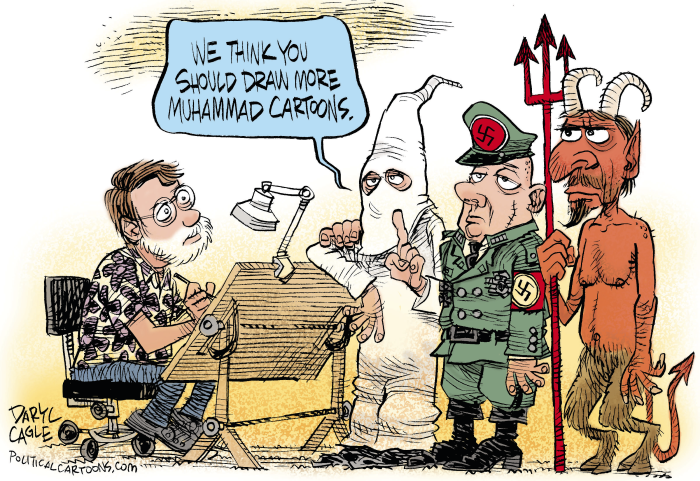






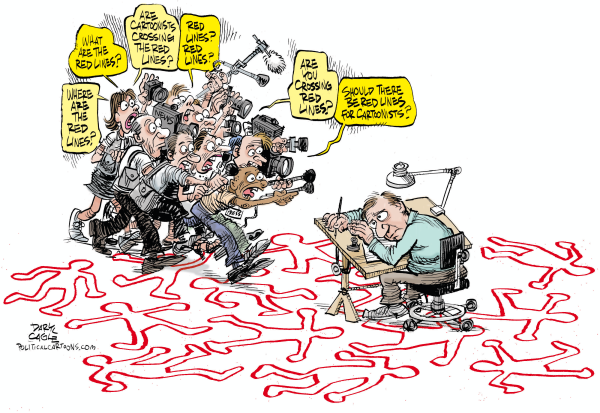


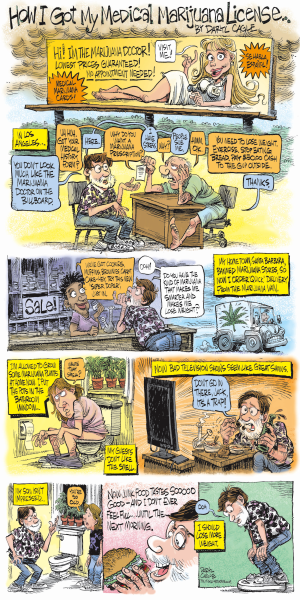









 There are rules to political cartoons that allow cartoonists to draw in an elegant, simple, shorthand that readers understand. Exaggeration is a well worn tool of political cartoonists; we use it all the time. I’ve drawn
There are rules to political cartoons that allow cartoonists to draw in an elegant, simple, shorthand that readers understand. Exaggeration is a well worn tool of political cartoonists; we use it all the time. I’ve drawn 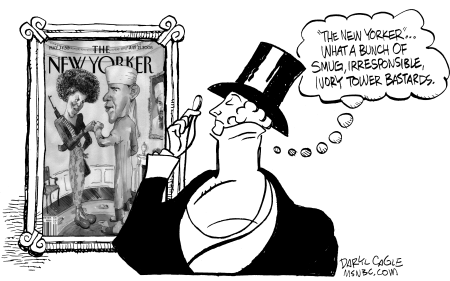


 It would be funny if it weren’t so true. I scanned the Dilbert cartoon (right) from my local Santa Barbara News-Press. A casual reader might read the last panel of the cartoon as the gag (the “awful thing” that is happening to the character is that terrible AM 1290 Santa Barbara News-Press Radio! ARRGH!) But no, it is just Dilbert, proving that he pulls his own weight by generating ad revenue in one of the panels.
It would be funny if it weren’t so true. I scanned the Dilbert cartoon (right) from my local Santa Barbara News-Press. A casual reader might read the last panel of the cartoon as the gag (the “awful thing” that is happening to the character is that terrible AM 1290 Santa Barbara News-Press Radio! ARRGH!) But no, it is just Dilbert, proving that he pulls his own weight by generating ad revenue in one of the panels.


 I met Jianping Fan on my recent trip to China. He hails from Guangzhou (formerly Canton) in steamy Southern China. The cartoonists in Guangzhou seem to have more freedom than cartoonists in other parts of China, because they live near Hong Kong where the Chinese are used to seeing much more of the news on TV than elsewhere in China – I think Jianping’s work shows that freedom and is pretty worldly-wise.
I met Jianping Fan on my recent trip to China. He hails from Guangzhou (formerly Canton) in steamy Southern China. The cartoonists in Guangzhou seem to have more freedom than cartoonists in other parts of China, because they live near Hong Kong where the Chinese are used to seeing much more of the news on TV than elsewhere in China – I think Jianping’s work shows that freedom and is pretty worldly-wise. 
 4) Sergey Elkin works from Moscow and his cartoons appear in Russia, Ukraine and Kazakhstan. As Sergei puts it: “Mostly I draw Putin.”
4) Sergey Elkin works from Moscow and his cartoons appear in Russia, Ukraine and Kazakhstan. As Sergei puts it: “Mostly I draw Putin.”
 5) I remember seeing Randy Jones‘ work for many years. His work sits on the borderline between political cartoons and illustrations, which, to my eye, makes them more sophisticated.
5) I remember seeing Randy Jones‘ work for many years. His work sits on the borderline between political cartoons and illustrations, which, to my eye, makes them more sophisticated. 
 6) Martin Kozlowski is the ringleader of the
6) Martin Kozlowski is the ringleader of the 

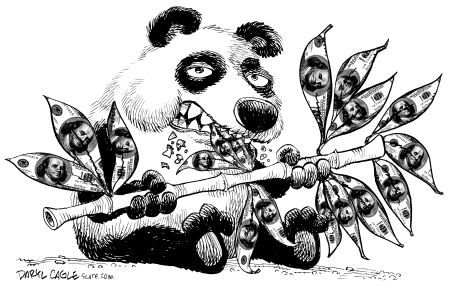




 Steve Nease, Oakville Ontario, Steve is the daily cartoonist for the Oakville Beaver –
Steve Nease, Oakville Ontario, Steve is the daily cartoonist for the Oakville Beaver – 

 Mike Luckovich, The Atlanta Journal-Constitution
Mike Luckovich, The Atlanta Journal-Constitution

 Jerry Holbert, Boston, MA, The Boston Herald
Jerry Holbert, Boston, MA, The Boston Herald
 Gary Brookins, Virginia — The Richmond Times-Dispatch
Gary Brookins, Virginia — The Richmond Times-Dispatch


 Jim Day,
Jim Day,